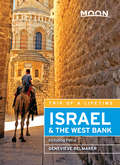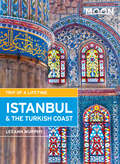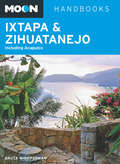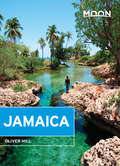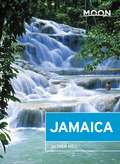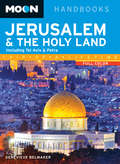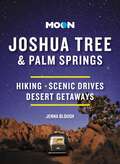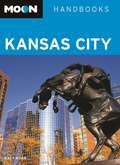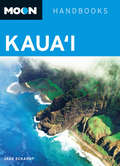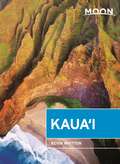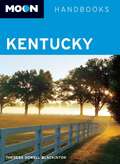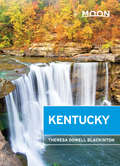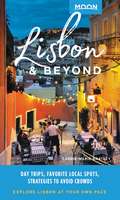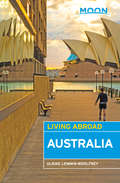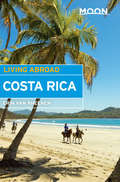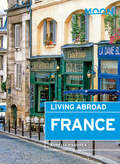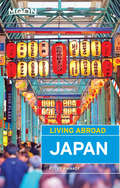- Table View
- List View
Moon Israel & the West Bank: Including Petra (Moon Handbooks Ser.)
by Genevieve BelmakerThis full-color guide to Jerusalem includes vibrant photos and helpful planning maps.Calls to prayer echo out over valleys and rooftops. The wailing siren for Shabbat and the ringing of church bells are omnipresent. This is a city of religious pilgrimages and a land of ancient stories, where even the bodies of water whisper of history and miracles.This is the trip of a lifetime. It will leave you with a new sense of wonder-and some great stories to share. In this full-color book, expert traveler Genevieve Belmaker tells you everything you need to know to make this trip possible:How to get there, how long it will take, and where to stop along the way-including information on Jerusalem, Tel Aviv, Haifa, the West Bank, Eilat, and Petra, JordanHow to choose the best tours and means of transportation, including tips on border crossings.Background on religious and cultural sites, from the Western Wall and Dome of the Rock to the Church of the Nativity-and where to find them
Moon Israel & the West Bank: Planning Essentials, Sacred Sites, Unforgettable Experiences (Travel Guide)
by Genevieve BelmakerAncient stories meet modern cities in this deeply significant region where the past is always present. Take the trip of a lifetime with Moon Israel & the West Bank. Inside you'll find:Flexible, strategic itineraries including a week in Jerusalem, three days in Tel Aviv, and a month exploring the region plus excursions to the West Bank, the Dead Sea, and Petra The top sights and unique experiences: Visit the Church of the Holy Sepulchre or pay respects at the Western Wall, and stop at holy sites throughout Northern Israel and the West Bank. Feast on falafel, hummus, and shaksuka and haggle for antiques at a market in Jerusalem. Bike through Tel Aviv's charming Neve Tzedek neighborhood or relax at one of its beaches. Float in the Dead Sea, watch the sun set over the massive Negev craters, or stay overnight in a Bedouin tent encampment Local insight: Journalist and longtime Jerusalem resident Genevieve Belmaker shares the history and culture of her beloved former home Full-color, vibrant photos throughoutDetailed maps for exploring on your own, and useful tips on border crossings and checkpoints Thorough background information on the landscape, history, government, and culture Handy tools and planning essentials including Hebrew and Arabic phrasebooks, health and safety tips, customs and conduct, and information for LGBTQ, female, and senior travelers, families with children, travelers of color, and travelers with disabilities Focused coverage of Jerusalem, Tel Aviv, Haifa, the North Coast, the Galilee and the Golan Heights, the West Bank, Eilat and the Negev, and Petra, Jordan Experience the best of Israel and the West Bank with Moon's practical advice and insider tips. Exploring further? Check out Moon Egypt.About Moon Travel Guides: Moon was founded in 1973 to empower independent, active, and conscious travel. We prioritize local businesses, outdoor recreation, and traveling strategically and sustainably. Moon Travel Guides are written by local, expert authors with great stories to tell—and they can't wait to share their favorite places with you. For more inspiration, follow @moonguides on social media.
Moon Istanbul & the Turkish Coast: Including Cappadocia (Moon Handbooks)
by Leeann MurphyThis full-color guide to Istanbul and the Turkish coast includes vibrant photos and easy-to-use maps to help with trip planning.Over its 8,000-year history, Turkey's crown jewel has won the hearts of emperors and sultans. Today, Istanbul is a lively meeting place of East and West, religious and secular, traditional and modern. From the golden sands of the Mediterranean's beaches to the the world-class shopping and dining of Istanbul's charming neighborhoods; from the sublime hills of the the Turquoise Coast's Lycian Way to the architectural marvels of the Thracian Peninsula: this is the trip of a lifetime.In Moon Istanbul & the Turkish Coast, expert traveler Leeann Murphy tells you everything you need to know to make this trip possible.Experience the life of the city by wandering the Grand Bazaar and sampling authentic Turkish coffee and mezes.Appreciate Istanbul's past at the many historic and cultural sites, including the Ayasofya, the Blue Mosque, and Topkapi Palace.Plan a cruise along the Aegean Sea and the Turquoise Coast.Make inland excursions to Cappadocia and Ankara.Choose the best guides, tours, and means of transportation-including bus, boat, and even hot-air balloon.
Moon Ixtapa & Zihuatanejo
by Bruce WhippermanMoon Spotlight Ixtapa & Zihuatanejois a 60-page compact guide covering the best of Ixtapa and Zihuatanejo. Author Bruce Whipperman offers his firsthand advice on must-sees, and sightseeing highlight maps make planning your time easy. This lightweight guide is packed with recommendations for entertainment, shopping, recreation, accommodations, food, and transportation, and helpful maps will guide travelers through this popular vacation getaway. This Spotlight guidebook is excerpted fromMoon Acapulco, Ixtapa & Zihuatanejo.
Moon Jamaica (Moon Handbooks Ser.)
by Oliver HillMake your Escape with Moon Jamaica! Come to Jamaica for its tropical climate and calm Caribbean waters; stay to explore the heart of its vibrant culture and spirit with Moon Jamaica! What You'll Find in Moon Jamaica:Expert advice from local author Oliver Hill, who shares the best-kept secrets of his island homeFull-color, vibrant, helpful photos Detailed directions and maps for exploring on your ownIn-depth coverage of Negril and the West Coast, Montego Bay and the Northwest Coast, Ocho Rios and the North Central Coast, Port Antonio and the East Coast, Kingston and the Blue Mountains, The South CoastActivities and ideas for every traveler: Surf the turquoise waters, or relax on white sands. Get your adrenaline fix by cliff jumping or climbing the Blue Mountains. Hike through lush jungle to magnificent waterfalls, or move to the beat of Kingston's legendary music scene. Sample Jamaican rum and coffee, or dine beachfront at a luxurious resort. Eat freshly picked fruit for breakfast, watch hummingbirds flit about tropical flowers, or bathe in a crystal-clear spring on a hot day.Strategic itineraries in an easy-to-navigate format, such as The Best of Jamaica, Roots and Culture, and Hidden Beaches and Hillside HikesCurrent background information on the landscape, culture, history, and environmentEssential insight for travelers on health and safety, transportation, and accommodations, packaged in a book light enough to fit in your beach bagWith Moon Jamaica's practical tips, myriad activities, and an insider's view on the best things to do and see, you can plan your trip your way.Looking for more fun in the Caribbean sun? Check out Moon Aruba or Moon Dominican Republic.
Moon Jamaica (Travel Guide)
by Oliver HillDive in to warm Caribbean waters, soak up the sunshine, and discover the vibrant culture and spirit of Jamaica. Inside Moon Jamaica you'll find:Flexible, strategic itineraries with ideas for backpackers, beach-lovers, adventure travelers, honeymooners, wellness-seekers, and moreTop activities and unique experiences: Watch hummingbirds flit about tropical flowers, take a dip in a crystal-clear spring on a hot day, or relax on soft white sands. See beloved local bands perform at a Negril nightclub and move to the beat of Kingston's legendary music scene. Savor sweet Jamaican rum and coffee, chow down on authentic jerk chicken, or have a romantic beachfront dinnerOutdoor adventures: Cliff-jumping into azure waters, surf the waves, climb the Blue Mountains, or hike through lush jungleFind the best beaches for surfing, sunsets, seclusion, and moreInsight from Kingston local Oliver Hill on how to experience Jamaica like an insider, support local and sustainable businesses, avoid over-tourism, and respectfully engage with the cultureFull-color photos and detailed maps throughoutBackground information on Jamaica's landscape, history, and cultural customsHandy tools including a glossary of Jamaican Patois terms, packing suggestions, and tips for women traveling alone, families with kids, seniors, and LGBTQ travelersExperience the best of Jamaica with Moon.Exploring more of the Caribbean? Check out Moon Bahamas, Moon Aruba, or Moon Dominican Republic.
Moon Japan: Plan Your Trip, Avoid the Crowds, and Experience the Real Japan (Travel Guide)
by Jonathan DeHartFrom the world's busiest intersection to the most serene hot springs, modernity and tradition mingle in Japan. Experience the natural wonder and rich culture of a country unlike any other with Moon Japan. Inside you'll find:Flexible itineraries including a two week 'Best of Japan' and a week in and around TokyoStrategic advice for spiritual seekers, anime fans, foodies, fashionistas, hikers, and moreThe top sights and unique experiences: Wander the shrines and temples of Ueno-koen park and stop in Tokyo National Museum for world-renowned Japanese art. Learn about samurai heritage in Sanmachi Suji or zazen meditation at the Buddhist temples of Kyoto, and get an unforgettable lesson in 20th century history at Hiroshima Peace Memorial Park Outdoor adventures: Hike the trails of Mt. Fuji or the river-filled valley of Kamikochi and relax in a communal onsen hot spring. Ski or snowboard at a world-class resort, surf in the Pacific off the coast of Shikoku, or dive along the coral reefs of OkinawaThe best local flavors: Feast on ramen or an elaborate spread of sushi, sample fresh seafood at the world's largest fish market in Tokyo, and drink your way through the famed beer scene in SapporoHonest insight from American expat and longtime Tokyo local Jonathan DeHartFull-color, vibrant photos throughoutDetailed maps and useful tips for navigating public transportation Focused coverage of Tokyo, Mt. Fuji, Kanazawa, Kyoto, Kansai, Hiroshima and Miyajima, Okinawa, Tohoku and Hokkaido, Shikoku and Kyushu, and moreThorough background information on the landscape, wildlife, history, government, and cultureHandy tools including health and safety tips, customs and conduct, and information for LGBTQ, female, and senior travelers, as well as families and travelers with disabilitiesWith Moon's practical advice and insider tips, you can experience the best of Japan.Exploring more of Asia? Check out Moon Vietnam.
Moon Japan: Plan Your Trip, Avoid the Crowds, and Experience the Real Japan (Travel Guide)
by Jonathan DeHartFrom the world's busiest intersection to the most serene hot springs, modernity and tradition mingle in Japan. Experience the natural wonder and rich culture of a country unlike any other with Moon Japan. Inside you'll find:Flexible itineraries including a two week 'Best of Japan' and a week in and around Tokyo The top sights and unique experiences: Wander the shrines and temples of Ueno-koen park and stop in Tokyo National Museum for world-renowned Japanese art. Learn about samurai heritage in Sanmachi Suji or zazen meditation at the Buddhist temples of Kyoto, and get an unforgettable lesson in 20th century history at Hiroshima Peace Memorial Park Outdoor adventures: Hike the trails of Mt. Fuji or the river-filled valley of Kamikochi and relax in a communal onsen hot spring. Ski or snowboard at a world-class resort, surf in the Pacific off the coast of Shikoku, or dive along the coral reefs of Okinawa The best local flavors: Feast on ramen or an elaborate spread of sushi, sample fresh seafood at the world's largest fish market in Tokyo, and drink your way through the famed beer scene in Sapporo Honest insight from American expat and longtime Tokyo local Jonathan DeHart Full-color, vibrant photos throughoutDetailed maps and useful tips for navigating public transportation Focused coverage of Tokyo, Mt. Fuji, Kanazawa, Kyoto, Kansai, Hiroshima and Miyajima, Okinawa, Tohoku and Hokkaido, Shikoku and Kyushu, and more Helpful resources on Covid-19 and traveling to Japan Thorough background information on the landscape, wildlife, history, government, and culture Handy tools including health and safety tips, customs and conduct, and information for LGBTQ, female, and senior travelers, as well as families and travelers with disabilities With Moon's practical advice and insider tips, you can experience the best of Japan. Just exploring the major cities? Check out Moon Tokyo, Kyoto & Hiroshima.About Moon Travel Guides: Moon was founded in 1973 to empower independent, active, and conscious travel. We prioritize local businesses, outdoor recreation, and traveling strategically and sustainably. Moon Travel Guides are written by local, expert authors with great stories to tell—and they can't wait to share their favorite places with you. For more inspiration, follow @moonguides on social media.
Moon Jerusalem & the Holy Land
by Genevieve BelmakerThis full-color guide to Jerusalem includes vibrant photos and helpful planning maps.Calls to prayer echo out over valleys and rooftops. The wailing siren for Shabbat and the ringing of church bells are omnipresent. This is a city of religious pilgrimages and a land of ancient stories, where even the bodies of water whisper of history and miracles.This is the trip of a lifetime. It will leave you with a new sense of wonder-and some great stories to share. In this full-color book, expert traveler Genevieve Belmaker tells you everything you need to know to make this trip possible:How to get there, how long it will take, and where to stop along the way-including information on Jerusalem, Tel Aviv, Haifa, the West Bank, Eilat, and Petra, Jordan.How to choose the best tours and means of transportation, including tips on border crossings.Background on religious and cultural sites, from the Western Wall and Dome of the Rock to the Church of the Nativity-and where to find them.This ebook and its features are best experienced on iOS or Android devices and the Kindle Fire.
Moon Jerusalem (Travel Guide)
by Genevieve BelmakerMoon Travel Guides: Your World, Your WayIn the timeless city of Jerusalem, the past feels ever-present. Thousands of years of epic history are visible on every stone of this thriving capital. Immerse yourself in the mesmerizing mix of ancient and modern with Moon Jerusalem.What you'll find in Moon Jerusalem:Strategic itineraries from three days to a week in Jerusalem, featuring pilgrimage destinations and historical sites for three of the worlds major religions Full-color guidebook with vibrant, helpful photos, all in an easy-to-navigate formatDetailed directions and maps for exploring on your own, as well as tips for choosing the best tours (the Saturday tours are free!)Activities and ideas for every traveler: Wind through the tightly packed shops of the Old City, and try your hand at the time-honored custom of haggling. Explore archaeological and cultural sites like the Western Wall, the Dome of the Rock, the Al-Aqsa Mosque, and the Church of the Nativity. Walk where many believe Jesus Christ was resurrected in the Church of the Holy Sepulchre, and look out over old and new Jerusalem from a rooftop café with a plate of shakshuka. Gain insight into the history of the Holocaust at Yad Vashem, and meditate on the sweeping views of the Jerusalem forest. Taste your way through Jerusalem's famous market the Shuk, or stay after the sun goes down to watch it turn into a lively street partyCurated advice from journalist and local expert Genevieve Belmaker, who shares what shes learned from her years living in this ancient and beautiful cityBackground info on the landscape, culture, and political historyEssential insight for travelers on safety, LGBTQ travel, local customs and etiquette, visas, and transportation in and around the cityAdditional resources like Hebrew and Arabic phrasebooks and suggested reading, packaged in a book slim enough to fit in your coat pocketWith Moon Jerusalem's practical tips, myriad activities, and an insiders view on the best things to do and see, you can plan your trip your way.Expanding your trip? Try Moon Israel & The West Bank. Hoping to country-hop? Check out Moon Istanbul & the Turkish Coast.
Moon Joshua Tree & Palm Springs (Travel Guide)
by Jenna BloughFrom the chic pools of Palm Springs to the rugged alien beauty of Joshua Tree National Park, soak up the California sunshine with Moon Joshua Tree & Palm Springs. Inside you'll find: Flexible itineraries, like relaxing weekends in Palm Springs and the Coachella Valley and the week-long best of Joshua Tree National Park, including day trips to the Salton Sea and IdyllwildStrategic advice for outdoor adventurers, spa-seekers, poolside loungers, and moreThe best hikes in Joshua Tree and the Palm Springs area marked with mileage, duration, difficulty level, and elevation gain, plus trailheads and detailed directionsTop activities and unique experiences: Discover hidden waterfalls, fan palm oases, and stunning canyons on a hike through Joshua Tree, or trek part of the Pacific Crest Trail on a day trip to the Sand to Snow National Monument. Try a rejuvenating sound bath, soak in serene hot springs, and discover hidden fan palm oases. Admire mid-century architecture and sip retro-chic cocktails in Rat-Pack-era hangouts, and sample the best of the party scene, from poolside resorts and live music venues to wild west saloonsInsider advice from SoCal local Jenna Blough on when to go, where to stay, and how to get around, including how to get to Joshua Tree and Palm Springs from Los AngelesFull-color photos and detailed maps throughout Background information on the landscape, history, and culture and tips for families, seniors, LGBTQ travelers, and visitors with disabilitiesExperience the best of the desert with Moon Joshua Tree & Palm Springs' practical tips and local insight.Exploring the national parks? Check out Moon Death Valley National Park or Moon Yosemite, Sequoia & Kings Canyon.
Moon Joshua Tree & Palm Springs: Hiking, Scenic Drives, Desert Getaways (Moon National Parks Travel Guide)
by Jenna Blough Moon Travel GuidesFrom the chic pools of Palm Springs to the rugged beauty of Joshua Tree National Park, soak up the California sunshine with Moon Joshua Tree & Palm Springs. Inside you'll find: Flexible itineraries, like a three-day camping trip in Joshua Tree National Park and a relaxing five-day stay in Palm Springs and the Coachella Valley, including day trips to Whitewater Preserve and Idyllwild Strategic advice for outdoor adventurers, spa-seekers, poolside loungers, and more The best hikes in Joshua Tree and the Palm Springs area marked with mileage, duration, difficulty level, and elevation gain, plus trailheads and detailed directions Top activities and unique experiences: Discover hidden waterfalls, fan palm oases, and stunning canyons on a hike through Joshua Tree, or trek part of the Pacific Crest Trail on a day trip to the Sand to Snow National Monument. Try a rejuvenating sound bath or soak in serene hot springs. Admire midcentury architecture and sip retro-chic cocktails in Rat-Pack-era hangouts and sample the best of the party scene, from poolside resorts to wild west saloons Insider advice from SoCal local Jenna Blough on when to go, where to stay, and how to get around, including how to get to Joshua Tree and Palm Springs from Los Angeles Full-color photos and detailed maps throughout Background information on the landscape, history, and culture Experience the best of the desert with Moon Joshua Tree & Palm Springs. Exploring California&’s national parks? Check out Moon Death Valley National Park or Moon Yosemite, Sequoia & Kings Canyon.About Moon Travel Guides: Moon was founded in 1973 to empower independent, active, and conscious travel. We prioritize local businesses, outdoor recreation, and traveling strategically and sustainably. Moon Travel Guides are written by local, expert authors with great stories to tell—and they can't wait to share their favorite places with you. For more inspiration, follow @moonguides on social media.
Moon Joshua Tree & Palm Springs: Hiking, Scenic Drives, Desert Getaways (Travel Guide)
by Jenna BloughFrom the chic pools of Palm Springs to the rugged beauty of Joshua Tree National Park, soak up the California sunshine with Moon Joshua Tree & Palm Springs. Inside you'll find: Flexible itineraries, like relaxing weekends in Palm Springs and the Coachella Valley and the week-long best of Joshua Tree National Park, including day trips to the Salton Sea and Idyllwild Strategic advice for outdoor adventurers, spa-seekers, poolside loungers, and more The best hikes in Joshua Tree and the Palm Springs area marked with mileage, duration, difficulty level, and elevation gain, plus trailheads and detailed directions Top activities and unique experiences: Discover hidden waterfalls, fan palm oases, and stunning canyons on a hike through Joshua Tree, or trek part of the Pacific Crest Trail on a day trip to the Sand to Snow National Monument. Try a rejuvenating sound bath or soak in serene hot springs. Admire mid-century architecture and sip retro-chic cocktails in Rat-Pack-era hangouts and sample the best of the party scene, from poolside resorts to wild west saloons Insider advice from SoCal local Jenna Blough on when to go, where to stay, and how to get around, including how to get to Joshua Tree and Palm Springs from Los Angeles Helpful resources on Covid-19 and traveling to Joshua Tree and Palm Springs Full-color photos and detailed maps throughout Background information on the landscape, history, and culture, plus tips for families, seniors, LGBTQ travelers, and visitors with disabilities Experience the best of the desert with Moon Joshua Tree & Palm Springs. Exploring California&’s national parks? Check out Moon Death Valley National Park or Moon Sequoia & Kings Canyon. About Moon Travel Guides: Moon was founded in 1973 to empower independent, active, and conscious travel. We prioritize local businesses, outdoor recreation, and traveling strategically and sustainably. Moon Travel Guides are written by local, expert authors with great stories to tell—and they can't wait to share their favorite places with you. For more inspiration, follow @moonguides on social media.
Moon Kansas City
by Katy RyanMissouri native Katy Ryan covers the best of the Kansas City area, including River Market, Crossroads, Westport, and Brookside. Ryan provides travel strategies including "The Best of Kansas City in 4 Days" and explores the city's notable restaurants, arts, and entertainment. Complete with expert tips that appeal to a variety of interests ranging from shopping to outdoor recreation, Moon Kansas City gives travelers the tools they need to create a more personal and memorable experience.
Moon Kaua'i
by Jade EckardtTravel writer and Hawai'i resident Jade Eckardt knows the best ways to experience Kaua'i, from catching waves in Hanalei Bay to watching the sun set over Ni'ihau from a beach on the West Side. InMoon Kaua'i,Eckardt offers a range of interesting activities for every traveler, with suggested itineraries like Best Waterfalls, Go Green on the Garden Isle, and Love of the Land#151;a guide to the island's best hikes. Packed with information on dining, transportation, and accommodations,Moon Kaua'igives travelers the tools they need to create a more personal and memorable experience.
Moon Kaua'i (Moon Handbooks)
by Kevin WhittonMake Your Escape!A verdant retreat full of old Hawaii charm, Kaua'i is aloha at its best. See the soul of Hawaii with Moon Kaua'i, the travel guide preferred by locals. What You'll Find in Moon Kaua'i:Expert, local author Kevin Whitton provides an adventurer's perspective on the island he calls homeFull-color guides with vibrant, helpful photos, in an easy-to-navigate formatDetailed directions and over 20 maps for exploring on your ownKaua'i travel itineraries for every trip and budget with options for rainy days, including: The Best of Kaua'i, Honeymoon Hotspots, Best Beaches, Underwater Paradise, Best Outdoor Adventures, Waterfall Wonders, and Best Cultural and Historic SitesIn-depth coverage for Lihu'e and the East Side, Princeville and the North Shore, Po'ipu and the South Shore, and Waimea and the West SideHonest advice on finding the best accommodations, accessible transportation, and experiencing the real Kaua'iActivities and ideas for every traveler: snorkel the coral reefs, ride the waves, or relax in the sun. Hike the famed Na Pali Coast or the breathtaking Waimea Canyon. Pick up paddle-boarding or learn to scuba dive. Discover the most beautiful waterfall or catch the best sunset for a romantic getawayNuanced background, including information on the landscape, plants and animals, history, and cultureHandy tools such as detailed lodging information and suggestions on LGBT+ travel and eco-tourism, all in a book light enough for your beach bagWith Moon Kaua'i's practical tips, myriad activities, and local insight on the best things to do and see, you can plan your trip your way. Interested in island hopping? Check out Moon Big Island of Hawai'i, Moon Honolulu & O'ahu, and Moon Maui. Visiting all the islands? Check out Moon Hawaiian Islands.
Moon Kentucky
by Theresa Dowell BlackintonNative Kentuckian Theresa Dowell Blackinton gives readers an insider's look at the Bluegrass State, from the revelry of the Kentucky Derby Festival to quiet, cool Mammoth Cave. Blackinton provides suggestions for unique trip itineraries, including Derby Fever Any Time of Year, Gone Fishin', and The Best of the Bluegrass State. Complete with tips on where to find the best bluegrass tunes and barbecue in Owensboro and how to rent a house boat to cruise the Land Between the Lakes Recreation Area, Moon Kentucky gives travelers to tools they need to create a more personal and memorable experience.
Moon Kentucky (Moon Handbooks)
by Theresa Dowell BlackintonNative Kentuckian Theresa Dowell Blackinton gives readers an insider's look at the Bluegrass State, from the revelry of the Kentucky Derby Festival to quiet, cool Mammoth Cave. Blackinton provides suggestions for unique trip itineraries, including Horsin' Around, Traveling the Bourbon Trail, and The Best of the Bluegrass State. Complete with tips on where to find the best bluegrass tunes and barbecue in Owensboro and how to rent a house boat to cruise the Land Between the Lakes Recreation Area, Moon Kentucky gives travelers to tools they need to create a more personal and memorable experience.
Moon Lisbon & Beyond: Day Trips, Local Spots, Strategies to Avoid Crowds (Travel Guide)
by Carrie-Marie BratleyFrom the vibrant azulejo tiles and colorful rooftops to the warm, golden coastline, get to know the charming City of Seven Hills with Moon Lisbon & Beyond.Explore In and Around the City: Wander Lisbon's most interesting neighborhoods, like Chiado, Castelo, Bairro Alto, and Belém, and nearby regions, including the Setúbal Peninsula, the Portuguese Riviera, and the Costa da CaparicaGo at Your Own Pace: Choose from over a dozen flexible itinerary options designed for foodies, beach-goers, history buffs, art lovers, and more, or customize your own adventure with recommendations for food, festivals and events, sights, and activitiesGet Outside the City: Venture through the fascinating Chapel of Bones in Évora, go surfing in Nazaré, relax by the tranquil river in Tomar, and sip the local cherry liqueur in Óbidos See the Sights: Hop on Tram 28 to explore the hilly capital, wander through 11th century castles, shop for artisan treasures at a local flea market, or soak up the vibrant colors of Lisbon's famous tiles at the Museu Nacional do AzulejoSavor the Flavors: Enjoy mouthwatering pasteis de Belém, order fresh grilled sardines at an outdoor bar, and people-watch as you snack on local cheese and charcuterieExperience the Nightlife: Catch a traditional folk music show in a neighborhood fado house, chat with locals over a pint in neighborhood pub, and sample delicious regional vintages at a chic wine barGet to Know the Real Lisbon: Follow suggestions from Portugal transplant Carrie-Marie Bratley on supporting local businesses and avoiding crowdsFull-Color Photos and Detailed MapsHandy Tools: Background information on Portugal's history and culture, plus tips on ethical travel, what to pack, where to stay, and how to get aroundDay trip itineraries, favorite local spots, and strategies to skip the crowds: Take your time with Moon Lisbon & Beyond.Exploring more of Europe? Check out Moon Venice & Beyond or Moon Barcelona & Beyond.
Moon Lisbon & Beyond: Day Trips, Local Spots, Tips to Avoid Crowds (Moon Europe Travel Guide)
by Carrie-Marie Bratley Moon Travel GuidesFrom the vibrant azulejo tiles and colorful rooftops to the warm, golden coastline, get to know the charming City of Seven Hills with Moon Lisbon & Beyond. Inside you'll find:Strategic, flexible itineraries designed for visiting top sights and local favorites, whether you have a few days, a week, or longer Must-see highlights and unique experiences: Hop on a tram to explore the hilly capital and marvel at 11th century castles. Shop for artisan treasures at a local flea market or soak up the vibrant colors of Lisbon's famous tiles at the Museu Nacional do Azulejo. Enjoy mouthwatering pasteis de Belém, order fresh grilled sardines at an outdoor bar, and people-watch as you snack on local cheese and charcuterie. Catch a traditional folk music show in a neighborhood fado house, chat with locals over a pint in a cozy pub, and sample delicious regional vintages at a hip wine bar Get outside the city: Escape the crowds with an easy day trip or short overnight stay. Venture through the fascinating Chapel of Bones in Évora, go surfing in Ericeira, relax by the tranquil river in Tomar, or marvel at grand palaces in Sintra Trusted, expert advice from longtime Portugal resident Carrie-Marie Bratley Background information on the city's history and culture, plus handy tips for getting around, traveling sustainably, avoiding crowds, and supporting local businesses Full-color photos and detailed maps throughout, plus a fold-out mapIn-depth coverage of neighborhoods, like Baixa, Chiado, Bairro Alto, and Belém, and nearby regions, including the Setúbal Peninsula, the Portuguese Riviera, and the Costa da Caparica Explore at your own pace and savor the city like a local with Moon Lisbon & Beyond. Visiting more of Europe? Check out Moon Norway or Moon Rome, Florence & Venice.About Moon Travel Guides: Moon was founded in 1973 to empower independent, active, and conscious travel. We prioritize local businesses, outdoor recreation, and traveling strategically and sustainably. Moon Travel Guides are written by local, expert authors with great stories to tell—and they can't wait to share their favorite places with you. For more inspiration, follow @moonguides on social media.
Moon Living Abroad Australia (Living Abroad Ser.)
by Ulrike Lemmin-WoolfreyMake Your Move!If you've imagined yourself creating a new life abroad, but don't know where to start, Moon Living Abroad Australia has the honest and practical answers you need to make it happen. Experienced expat and Melbourne resident Ulrike Lemmin-Woolfrey knows a thing or two about adjusting to a new country.Moon Living Abroad Australia provides:Practical information on setting up the essentials, including visas, finances, employment, education, and healthcareStrategic advice on planning a fact-finding trip before making the moveEssential tips on how to find a place to live that fits your needs, whether you're a renter or a buyerA thorough survey of the best cities and regions to liveA deep exploration of the varying cultures, geography, climates, and wildlife of the vast and expansive continentInterviews with other expats who share their personal experiences building successful lives abroadSpecial tips for those with children or petsFirsthand insight from someone who's done it all Moon Living Abroad Australia provides honest advice and essential tools for anyone looking to make a new home abroad. Making a life-changing move has never been easier.
Moon Living Abroad Costa Rica (Living Abroad Ser.)
by Erin Van RheenenMake Your Move!In many ways, Costa Rica is an expat paradise - known for its slower pace of life, peaceful and happy people, and raw wilderness. If you've imagined yourself creating a new life abroad, but don't know where to start, Moon Living Abroad in Costa Rica has the honest and practical answers you need. Moon Living Abroad in Costa Rica provides:Practical information on setting up the essentials, including visas, finances, employment, education, and healthcareWhat you need to know about Costa Rica's culture and language before making your moveNecessary tips on finding a place to live that fits your needs, whether you're a renter or a buyerA thorough survey of the best areas to live and whyA deep exploration of the geography, politics, and environment that defines Costa RicaInterviews with other expats who share their personal experiences building successful lives abroadSpecial tips for those with children or petsFirsthand insight from someone who's done it all Moon Living Abroad in Costa Rica provides honest advice and essential tools to create a new life abroad, and make Costa Rica feel like home. Making a life-changing move has never been easier.
Moon Living Abroad France (Living Abroad)
by Aurelia D'AndreaJournalist Aurelia d’Andrea knows what it takes to make the move to France--she’s done it twice. In Moon Living Abroad France, she provides insight and firsthand advice on navigating the language and culture of this enchanting European country, outlining all the information you need to manage your move abroad in a smart, organized, and straightforward manner. Moon Living Abroad France is packed with essential information and must-have details on setting up daily life, including obtaining visas, arranging finances, gaining employment, choosing schools, and finding health care. With color and black and white photos, illustrations, and maps to help you find your bearings, Moon Living Abroad France makes the transition process easy for businesspeople, adventurers, students, teachers, professionals, families, couples, and retirees looking to relocate.
Moon Living Abroad Italy (Living Abroad Ser.)
by John MorettiMoon Travel Guides: Make Your Move!From visas, to job-hunting, to cultural assimilation, get a head start on your life-changing move with Moon Living Abroad Italy.Inside you'll find:Practical information on setting up the essentials, including visas, finances, employment, education, and healthcareFirsthand insight on navigating the language and culture from John Moretti, an experienced expat who has lived in Italy for more than a decadeTips on finding housing that suits your needs and budget, whether you're renting or buyingA thorough survey of the many regions, provinces, and individual cultures that Italy encompasses, to help you find the right new home for youInterviews with other expats who share their personal experiences building successful lives abroadHow to plan a fact-finding trip before making the move to familiarize yourself with aspects of daily life in Italy: internet and phone access, schooling, banking, insurance, travel, transportation, and moreSpecial tips for those making the move with children or petsMoon Living Abroad Italy takes the hassle out of planning your move, giving you the insider tips, practical resources, and local know-how to start your new life abroad!
Moon Living Abroad Japan (Living Abroad Ser.)
by Ruthy KanagyMake Your Move!If you've imagined yourself creating a new life abroad, but don't know where to start, Moon Living Abroad in Japan has the honest and practical answers you need to make it happen. Making a life-changing move has never been easier. Moon Living Abroad in Japan provides:Practical information on setting up the essentials, including visas, finances, employment, education, and healthcareWhat you need to know about Japan's culture and language before making your moveEssential tips on how to find a place to live that fits your needs, whether you're a renter or a buyerA deep exploration of the many regions, provinces, and individual cultures that Japan encompasses, enabling you to discover the best new home for youInterviews with other expats who share their personal experiences building successful lives abroadSpecial tips for those with children or petsFirsthand insight from someone who's done it all In Moon Living Abroad in Japan, Japan expert Ruthy Kanagy provides readers with essential tools and honest advice for creating a new life abroad in her beloved home country.
